French artist Jean Dubuffet( 1901-1985) said that he was not a revolutionary but a permanent subversive. His work. however, coincided with attempts in other fields to dispute the accepted values of Western culture.The ethnologist Claude Levi-Strauss had convincingly shown that Western society is not superior to so called primitive societies and that there is nothing privileged about our modes of thought, our philosophies, or our artistic heritage.
Dubuffet as a painter and an anti-culture doctrinaire complemented this critical examination of Western cultural supremacy. Just as new drugs were being used to expand consciousness, experiments were going on to expand on the sanctioned limits of artistic creation. Serial music introduces chance in composition; the score gives the performer a choice, like a choice in routes to reach a destination, just as Dubuffet mixes Kem-Tone and oil paint because he knows it wil make smears in canvas. Dubuffet’s search for alternative culture had led him to rise above the accepted categories of beautiful and ugly, planned and unplanned, ordered and disordered, and to find his inspiration in the spontaneous creative impulses of nonprofessional artists, whose irrational, obsessive work he called ”raw art” or Art Brut. Their work supported his conviction that art is life’s department of aberrations.
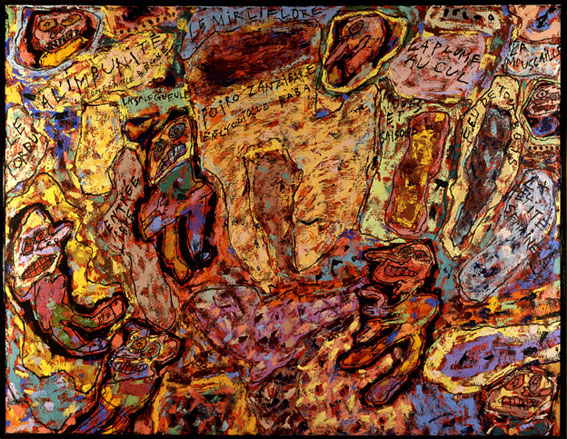
''Throughout his long career, Jean Dubuffet pioneered a provocative, rebellious attitude toward art and culture. Seeking direct contact with the forces of creation, Dubuffet found inspiration in what he called Art Brut (“raw art”)—art of the insane, non-Western art, children’s drawings, and graffiti. His use of unconventional materials, constituting a revolt against traditional definitions of beauty, influenced many twentieth-century artists.''
Art Brut is the need to create, disassociated from the need to communicate. It is intensely personal, solitary, and unmotivated by the urge to sell or show. An African mask or a fetish does not qualify because each has a social purpose. Children’s art does not qualify. Children are freed from the burden of acquired culture; they are blessed with freedom of invention; they can pass effortlessly from the real to the imaginary, but their vision is superficial, it is not sustained, and it becomes more conventional as they grow older.
Brut artists are adults out of kilter with society; many are in institutions, where they have the time to paint out their obsessions. One characteristic of Brut art is to use whatever is available, like bits of string, cork, eggshells, stones, or bone. There is also a sense of horror before the void, a need to fill up the page completely, to leave no blank spaces, and often to draw on both sides of the page or canvas. There is an absence of deliberate composition; the Brut painter begins in a corner and continues until all the space is filled. And finally there is the recurrence of the dual image, a face shown twice or a symmetrical design.
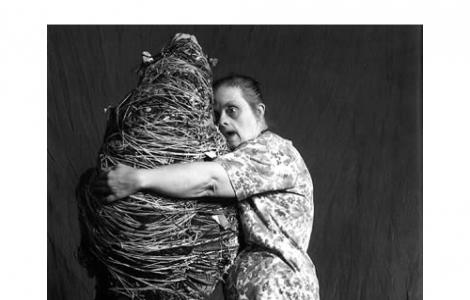
''In the image of authentic creativity found in Art Brut, as promoted by Jean Dubuffet, genuinely creative art is motivated by insubordination, and by a maverick self-assertion that is profoundly anti-social. Institutions do not foster true creativity, even where they are supposed to (schools, colleges, academies).''
Dubuffet adopted the use of odd materials and the absence of composition in his own work. He discovered Art Brut while performing his military service in the Eiffel Tower as a member of the French army’s meteorological service. A Parisian lady mailed the service a notebook in which she had recorded the flying objects and persons that she saw from her window. Dubuffet felt a strong attraction to the drawings, and soon after he read a book by the German doctor Hans Prinzhorn, ”The Plastic Productions of Psychopaths”, which confirmed his addiction to raw art.
The discovery of an art form that owed nothing to museums or academies, that was not a branch on the tree of Western culture but a separate shrub altogether, and was a major influence on his own work. It fitted in with his belief that art is a form of delirium and with his disdain for talent, which he calls mimicry. The Brut artists were outside the circuit; it did not occur to them to imitate acknowledged masters
anons of beauty. That so much of Art Brut came from insane asylums did not bother him.In 1945, he began prospecting for the work of Brut artists. Returning from a trip to Switzerland, Madame Dubuffet was asked by a friend how she had liked the mountains, ”Mountains!, all I saw were prisons and insane asylums”. Dubuffet obtained the work of Brut artists from psychiatrists and prison wardens and built up a collection that totaled over five thousand works from 170 artists. Half the work is from asylums and half by so called normal persons. The question then is whether all artists are psychopaths or the definition of normal should be altered.
, because professional art does not seem to me any more visionary or lucid; rather the contrary….Why then do you write that gold in its raw state is more fake than imitation gold? I like it better as a nugget than as a watchcase. Long live fresh-drawn, warm, raw buffalo milk.\””]![wolfli1 Adolf Wofli.Dubuffet:"I preferred ‘Art Brut’ instead of ‘Art Obscur’ [Obscure Art], because professional art does not seem to me any more visionary or lucid; rather the contrary....Why then do you write that gold in its raw state is more fake than imitation gold? I like it better as a nugget than as a watchcase. Long live fresh-drawn, warm, raw buffalo milk."](/wp-content/uploads/2010/03/wolfli1.jpg) Dubuffet was not himself a Brut artist, for he was squarely within the commercial circuit, had never been committed to a mental home, and he changed his style almost every year. His compulsion to paint is a highly organized one. Certainly Dubuffet went against the canons of French art, with its worship of clarity and line. He began with portraits of his friends because he saw the portrait as the privileged genre of Western art, resting on a humanist conception of man’s nobility. His portraits, with their exaggerated features, warts, and grimaces, are far from noble, but they bear an alarming resemblance to their subjects that no photograph or academic portraitist could render. For Dubuffet, portraits were no different than lanscapes; they contained open spaces, ravines,knolls, hollows and shrubbery.
Dubuffet was not himself a Brut artist, for he was squarely within the commercial circuit, had never been committed to a mental home, and he changed his style almost every year. His compulsion to paint is a highly organized one. Certainly Dubuffet went against the canons of French art, with its worship of clarity and line. He began with portraits of his friends because he saw the portrait as the privileged genre of Western art, resting on a humanist conception of man’s nobility. His portraits, with their exaggerated features, warts, and grimaces, are far from noble, but they bear an alarming resemblance to their subjects that no photograph or academic portraitist could render. For Dubuffet, portraits were no different than lanscapes; they contained open spaces, ravines,knolls, hollows and shrubbery.
From portraits he progressed to the female form in his famous series ”Corps de Dames” which probably provoked more indignation than any of his other styles because he was attacking woman as a privileged artistic subject, a tradition going back to the Greek veneration of Venus as an aesthetic ideal. The ladies felt insulted as seeing themselves portrayed as though a steamroller had passed over their lovely shapes. Dubuffet intended no disrespect. He wanted he said, ” to carry the celebration of woman to a level where beauty and ugliness are no longer meaningful, but I observed that the ladies did not wish to be transported to such a lofty plane.”
He then began his ”Haute Pate” series with paintings of a pebbly appearance, piling on layer after layer of paint and other materials with a trowel to give the impression that the canvas is bubbling up in an early stage of volcanic eruption. Bitumen was also used and some of his ”Hautes Pates” began to melt when placed over radiators by collectors. Dubuffet was delighted that his paintings were sensitive to temperature changes, insisting that the effect was intentional, and dubbed it ”hippopotamus’ sudations”.
Dubuffet felt that paintings in which there was no trace of composition or brushstrokes would be the ”coup de grace” in his demolition of conventional art; he could this banish the artist . He used turpentine and oil as a mixture which made fissures and smears on the canvas. He then waited until the mixture was almost dry, and then he tore it off with a knife so that the canvas looked like scraped skin. He heaped color over color with a spatula to obtain a dull light that looked as though it was coming from behind the canvas. ” The essential gesture is to smear” , he said of art, yet this was too deliberate for Dubuffet.


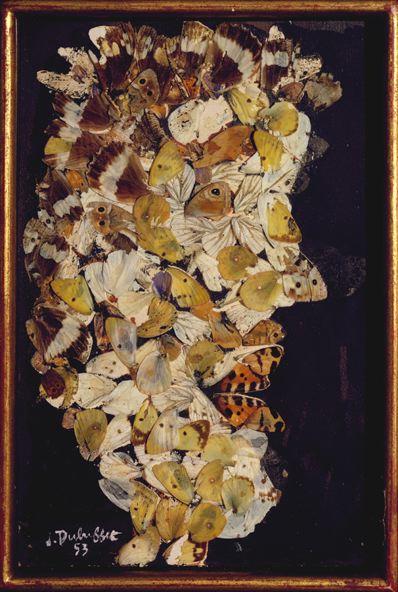
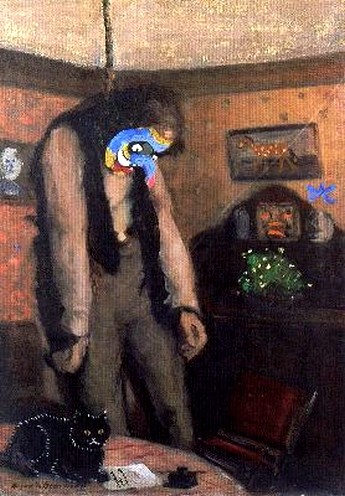
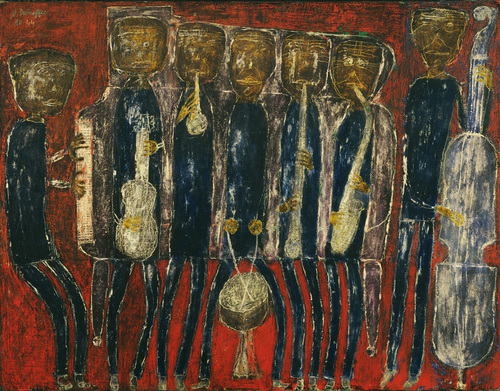
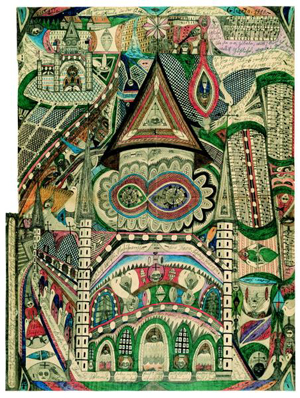



 COMMENTS
COMMENTS